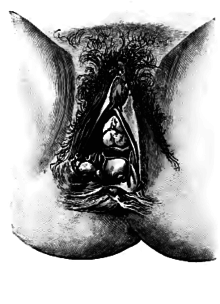Perineal tear
| Classification according to ICD-10 | |
|---|---|
| O70 | Perineal tear under the birth |
| ICD-10 online (WHO version 2019) | |
A perineal tear is the tearing of the tissue between the vulva and anus , the perineum , as a result of excessive stretching during birth . Most of the time, a tear occurs when the newborn's head or shoulders pass through. This usually takes place at the weakest point of the tissue, i.e. median from the vaginal entrance towards the anus.
Degrees of severity

Dam cracks are divided into four degrees of severity, depending on their extent:
- Perineal tear I. °:
Only the skin ( cutis ) and the subcutaneous tissue ( subcutis ) of the perineum are injured (but not the perineum muscles themselves). - Perineal
tear II °: tear of the perineum muscles up to the maximum of the external anal sphincter muscle ( muscle sphincter ani externus ). - Perineal
tear III. °: tear also of the external anal sphincter. - Perineal
tear IV. ° tear also of the mucous membrane of the rectum .
In addition, lacerations of the labia , the clitoris , the cervix and the uterus are possible. The woman barely notices the tearing of the perineum during childbirth, as this usually occurs in the course of a contraction with a strongly stretched perineum at the same time. However, in the period after the birth, pain can occur when sitting, walking, defecating or exercising. Women rarely suffer from permanent pain during sexual intercourse ( dyspareunia ) as a result of a dam injury .
prevention
Factors such as the elasticity of the tissue, the size of the child, the preparation of the perineum, the speed of delivery and the implementation of perineal protection can all influence the likelihood of a tear injury. Perineal massages during pregnancy, for example, can loosen the tissue and prepare it for the birth. Some obstetricians / midwives use warm compresses to also increase the elasticity of the tissues. In addition, a birth gel can help to shorten the birth and prevent perineal tears by reducing the frictional force in the birth canal.
treatment
If a perineal tear occurred during birth, different treatments of the tear are necessary, depending on the severity. Small first-degree perineal tears can heal without a suture after the check-up, while deeper tears are sutured in layers to ensure the functional position of all tissues. DR III ° and IV ° in particular must receive professional medical care in order to avoid impairment of continence . Perineal cracks usually heal well. Heavy bleeding as well as inflammation and the resulting secondary healing are rare with good hygiene. When the perineum injury is properly cared for by the doctor or midwife, local anesthesia is usually used to avoid further pain.
Perineal tear and incision
The stretching of the birth canal at birth does not always cause the perineum to tear. Nevertheless, perineal incision to prevent perineal rupture had become established in everyday clinical practice in the past few decades , which in some clinics led to perineal incision rates of up to 50%. In recent years the topic has been reassessed, so that today controlled tearing is often preferred to a perineal incision. Arguments in favor of this approach are that perineal tears are often only minor injuries, which also often only affect weak tissue areas (less often the muscles) and heal more easily than a targeted incision. As an argument against it, however, it is put forward that perineal tears can continue to tear in an uncontrolled manner until the sphincter muscles of the anus or the mucous membrane of the rectum can also be affected. In terms of child and maternal health, the need for a perineal incision must therefore be assessed individually. The routine perineal incision is just as unnecessary as avoiding a perineal incision for dogmatic reasons, as there are many situations in which a perineal incision is unavoidable to avoid endangering children. The shortening of the expulsion phase in child emergencies, a very high, tight perineum, vaginal surgical termination of labor or premature birth are common reasons to prefer a perineal incision to protect the child over the perineal tear that may be avoidable on the mother's side. The perineal cut also offers the advantage of reducing the pressure load on the child's head. If necessary, the incision can also be lengthened without endangering the anus sphincter .
Dam cracks in non-human primates and other animals
Perineal tears as complications in childbirth are not a purely human phenomenon. So z. For example, dam cracks have been reported regularly in horses and cattle. A perineal rupture is also known from a western lowland gorilla (although in connection with the birth of Siamese twins ).
Individual evidence
- ↑ AF Schaub ua: Obstetric gel shortens second stage of labor and prevents perineal trauma in nulliparous women: a randomized controlled trial on labor facilitation. In: J. Perinat. Med. 36, 2008, pp. 129-135.
- ↑ NS Saini, J. Mohindroo, SK Mahajan, M. Raghunath, V. Sangwan, A. Kumar include: Surgical management of third degree perineal laceration in young mares. In: The Indian Journal of Animal Sciences. 83 (5) 2013, pp. 525-526.
- ↑ DJ Dreyfuss, EP Tulleners, WJ Donawick, NG Ducharme: Third-degree perineal lacerations and rectovestibular fistulae in cattle: 20 cases (1981-1988). In: Journal of the American Veterinary Medical Association. 196 (5), 1990, pp. 768-770.
- ↑ S. Langer, K. Jurczyński, A. Gessler, FJ Kaup, M. Bleyer, K. Maetz-Rensing: Ischiopagus Tripus Conjoined Twins in a Western Lowland Gorilla (Gorilla gorilla). In: Journal of comparative pathology. 150 (4), 2014, pp. 469-473.
Web links
- Familienplanung.de - Dammriss : The information portal of the Federal Center for Health Education (BZgA)
- S1 guideline perineal tear III. and IV. degree after vaginal birth, management of the German Society for Gynecology and Obstetrics. In: AWMF online (as of October 2014) (in revision)